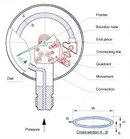I disconnected my SPG and there were indeed some small water droplets on the spool. Used scuba tank and air nozzle to blow air inside spg and through hose.Best practice is to take off the SPG hose, and then blow air through it through the first stage. Otherwise, you risk pushing water into the SPG.
Also removed and opened my swift transmitter. Had to put in new battery anyways. No visible water. Will leave it out of its housing and let it air dry for a week.
Thanks for advising on this! I wouldn't have thought to do what I did just now.




